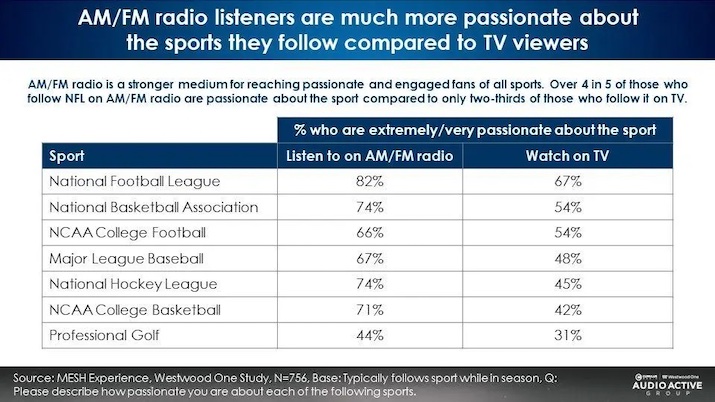Proposed Legislation Could Save AM Radio in Cars
Sports talk radio — not to mention the EAS — relies on the much maligned spectrum
Story Highlights
The first sports–talk-radio show in history launched in March 1964 on AM station WNBC New York, hosted by local broadcast-sports institution Bill Mazer. Drivers in the tri-state area tuned in in droves to hear Mazer wax wildly — his nickname was “The A-Maz-In” — on area NHL, NFL, and baseball teams.
Today, thanks to a bipartisan effort by a group of lawmakers, drivers will continue to enjoy Mazer’s descendants the way God intended: in a part of the RF spectrum that emphasizes the adenoidal tonalities of the human voice but, like no other medium, imparts a visceral excitement to the audio-only narrative of sports.
The proposed legislation — scheduled to be introduced this month by Sens. Ed Markey (D-MA), Ted Cruz (R-TX-), and others — would require all new vehicles to continue to include AM radios at no additional charge. The lawmakers want to make it illegal for carmakers to eliminate AM radio from their cars, arguing that public safety is at risk.
“The importance of AM radio during large-scale emergencies cannot be underestimated,” Rep. Josh Gottheimer (D-NJ), the lead sponsor in the House, told Axios. “It has, without a doubt and without interruption, saved lives and kept our communities informed.”
Some carmakers have already eliminated AM radios as standard equipment on new cars; this year, Ford announced that it will remove AM radios from most 2024 models. Electric-vehicle manufacturers in particular argue that interference from their motors causes interference in the band.
 However, nearly 50 million people still listen to AM radio, according to Nielsen figures provided by the National Association of Broadcasters. In fact, on May 23, Ford CEO Jim Farley declared that the automaker is reversing its previously announced plan to remove the AM radio from its vehicles, both electric and gasoline-powered, citing the importance of AM broadcast radio as a part of the U.S. Emergency Alert System (EAS).
However, nearly 50 million people still listen to AM radio, according to Nielsen figures provided by the National Association of Broadcasters. In fact, on May 23, Ford CEO Jim Farley declared that the automaker is reversing its previously announced plan to remove the AM radio from its vehicles, both electric and gasoline-powered, citing the importance of AM broadcast radio as a part of the U.S. Emergency Alert System (EAS).
The Sound of AM
There is some consensus that AM radio brings a unique immediacy to broadcast sports and that a lack of an AM radio would put a serious crimp in the sound of broadcast sports on the radio.
“AM audio is typically processed much more aggressively than FM,” explains Jeff Keith, senior product development engineer, Audio Processing Development, Wheatstone Corp. “Increasing the average modulation density not only increases AM service-area coverage — something it does not do for FM — but also adds urgency to the audio that likely has nothing to do with audio bandwidth. That same feeling of urgency created by aggressive audio processing can also add a bit of ‘authority’ to the audio. Bigger is better, or at least seems more important, and is the underlying psychological reason many stations process to be louder than other stations in the market.
“Sports is generally a high-energy activity for both players and audience anyway,” he continues. “Hearing it on AM, processed ‘hard’ as most AM [broadcasts] do, adds even more energy to the listening experience, regardless of the audio bandwidth.”
Aside from any technical reasons for it, though, Keith agrees that AM radio creates a particular ambience for broadcast sports: “For me, hearing programming on AM brings back nostalgia for how things were back when I was first listening to radio. That nostalgia puts my brain in a place that FM has never been able to.”
Fatal Flaws?
Radio seems to attract the most rabid sports fans. In a study of 756 fans conducted in October 2022 by MESH Experience/WestwoodOne, a far greater proportion of AM/FM radio listeners said they are “extremely/very passionate” about sports, compared with TV viewers. The fact that AM radio endures this deeply into a digital era underscores its robustness.
Even so, it has potentially fatal technical and regulatory flaws. One issue is noise: the AM band is prone to interference from power lines, auto ignition, fluorescent lights, motors, CLFs, and any electronic equipment with a switch-mode power supply. Today, that includes almost everything everywhere. Weak signals are swamped by noise, and even strong signals can suffer.
On the regulatory side, AM stations lose listeners at night because the FCC makes some of them cut power or shut down completely to prevent interference to other stations on the same frequency. AM-signal propagation in the 535- to 1705-kHz range is cut drastically from day to night, which is also when less upper-layer ionization causes the AM signal to refract and skip hundreds or even thousands of miles, often creating interference with distant stations and requiring the use of complex and expensive directional antenna systems to solve the problem.
Because of the format’s continued ubiquity and integration with the EAS, AM radio will apparently be part of the digital dashboard for the foreseeable future. In fact, Ford’s Farley went one step further, saying that, for the automaker’s two electric vehicles already released without AM-radio capability, a software update will be pushed to restore it.
And sports-radio stations that, like WSCR Chicago, which is branded 670 The Score, have incorporated their frequency into their name won’t have to change their stationery anytime soon.
